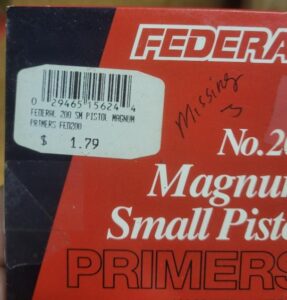Clearly it has been a while since I loaded a large batch of .357 Mag.
Tag Archives: reloading
.357 rambling
Someone was nice enough to send me an early Paratus gift the other day…a Priority Mail box full of fired .357 Mag brass. Much to my surprise, it turns out that while I have, literally, buckets of .38 Spl. brass I was a bit light on .357 brass. So, this was a very welcome gift and I am grateful to the person who sent it.
Although I like the .44 Mag as much as the next guy, and I carry a .44 when I’m in the woods, my preferred revolver cartridge for survivalist needs is the .357 Magnum. Bullet selection is absurdly large, I can shoot light, cheap, and pleasant .38 Spl. interchangeably, and the guns can be a tad smaller than the .44’s. Is it my first choice for things with teeth and claws? No..although it’ll suffice in a pinch. But it is my first revolver choice for things with language skills and lapses in respect for individual rights.
Although the ‘ideal’ is a 125 gr. JHP, I prefer a bit more bullet weight…I usually go with the standard 158~ gr. JHP. If I’m after penetration, I switch over to the 125 gr. Lyman #358093 cast from linotype. It’ll penetrate everything that isn’t from Krypton. Realistically, though, a good hard cast bullet of just about any shape will outperform a jacketed one in terms of penetration, assuming equal velocities for both.
As for the launching platform, I am a fan of the Ruger GP-100 for my .357 needs. This is based on a criteria that is heavily weighted towards durability and ruggedness. The GP is about the same frame size as a Colt Python or Smith L-frame (and I do love me some S&W 681) and, often, holsters and speedloaders between the three will interchange. The GP has a couple features that, in addition to its Ruger ruggedness, make it a winner for me….the easily swappable front sight inserts are sweet, and I like the modularity of the trigger group for disassembly.
Ruger’s SP-101 series of snubbies is also a winner if you’re willing to tote the weight of a five-shot snubby made out of stainless steel. But, for the end of the world, a little extra weight might be an acceptable tradeoff for a gun that is nigh unkillable.
Out of a carbine, like my lovely Marlin 1894, the .357 Mag picks up a bit of velocity and becomes a very zippy, very controllable carbine cartridge for less-than-intermediate range. Basically, any distance you’d be comfortable with open sights will work. For my needs, thats about 100 yards.
While I’d rather ride out Katrinaville with a Glock and an AR, I wouldnt’ feel terribly undergunned with a pistol/carbine combo in .357. And, of course, being chambered for one cartridge makes logistics a bit more streamlined.
Although I carry a Glock as a matter of routine, I do carry a revolver from time to time in my daily life. In a post-apocalyptic world, the revolver has a lot going for it in terms of ammunition flexibility, retention of empties for reloading, and ability to digest ammo that might choke an auto. The drawback, of course, is that when a revolver has an issue you pretty much have to have a gunsmith….with something like a Glock all you need is some drop-in spare parts.
But, I digress…..I likes me some .357, and I thank the thoughtful reader who sent me the brass (and winds up getting on my Paratus card list). There’s no such thing as ‘too much’ when it comes to reloadable pistol brass.
More buying….
6,000 55 gr. FMJ bullets take up about the same space as a big city phonebook. (Remember phonebooks?) What’s really trippy is that in many markets, the small rifle primers needed for these are worth more than the bullets themselves.
I’ve a Dillon RL1050, literal buckets of .223 brass and carbide .223 dies. Time to get busy.
Backordered no more
So about this time last year I had set up the big Dillon 1050 to run off some .357 Magnum using my favorite load. And I discovered…much to my amazement…that I did not have nearly as much .357 Mag brass on hand as I thought. And it was a hell of a time to try and order more. But, I did. And was told it was backordered. And backordered. And backordered.
Until today:
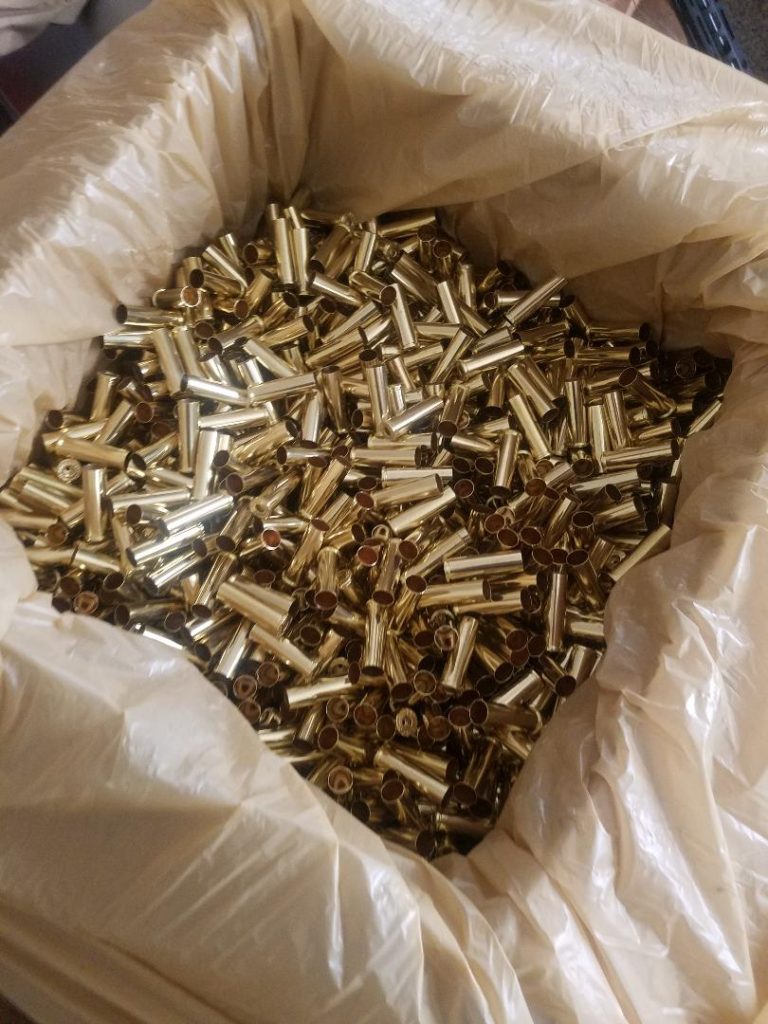 Thats 4,500 pieces of brand new .357 Mag brass. The Dillon will be getting quite the workout this weekend. And when I’m done, I package it in these from repackbox.com. They store neatly, uniformly, and take up a bit less space than the usual plastic box.
Thats 4,500 pieces of brand new .357 Mag brass. The Dillon will be getting quite the workout this weekend. And when I’m done, I package it in these from repackbox.com. They store neatly, uniformly, and take up a bit less space than the usual plastic box.
My goal is to have about half of these loaded by Sunday. And to take my Marlin .357 out for a spin and do a little shooting.
Ammo Security VI – Economics of reloading
There’s not a lot of things I consider myself an expert on. But, one thing I genuinely do think of myself as an expert on is reloading ammunition. I’ve done it all from .22 Hornet to .50-140, using every brand of press, jacketed and lead bullets, cast my own bullets, reformed my own brass, etc, etc.
I am also a tightwad with a streak of money nerd. Is reloading cost effective? Well, when you reload the cost of your ammo goes down so you wind up shooting more…so, in that regard it’s mostly a wash. But, on terms of shooting the same amount of ammo, it’s a different story. What I mean is, if you buy a box of .300 Win. Mag and then you reload that box of .300 Win. Mag. one is going to be a buttload cheaper than the other. Cheap enough to make it worth it? Let’s find out.
Let’s go with one of the belted mags……300 Win, 7mm Rem, .338 Win, .257 Weatherby….whatever. They all track around $2-$4 a round. Let’s buy 20 pieces of new brass, 100 premium bullets, a brick of primers, and a pound of powder.
I’m just gonna run over to GunBroker and get some prices….
- Federal .300 Win Mag 165 gr. Nosler Partition, 20 rounds for about $40
- Nosler Partitions, .30 165 gr, 100 bullets is about $45
- New brass from Winchester is about $30/50
- And we’ll use a load of 70 grains of IMR 4350 (There are 7000 grains of powder per pound, so under “Qty” one pound would be ‘7000’)
Factory ammo is $2. We can reload it for $1.39. But, once we fire it off and re-use the brass our cost per round drops to $0.79.
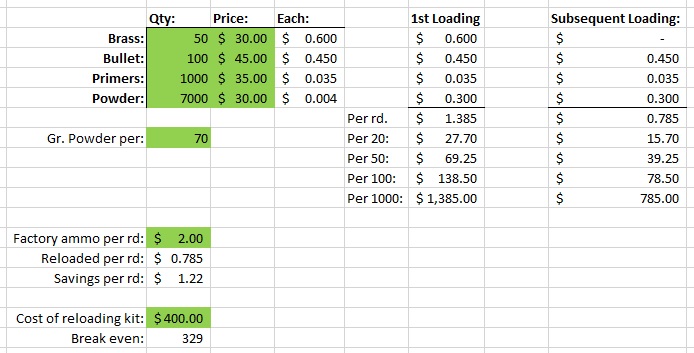 What if you reload something really spendy like .338 Lapua.
What if you reload something really spendy like .338 Lapua.
- Federal Premium 250 gr. Sierra MK 20 rounds for about $90
- Hornady brass at $3 each
- Sierra 250 MK at $40/50
- 76 grains of powder
Factory ammo is $4.50. We can reload it for $4.16. But, once we fire it off and re-use the brass our cost per round drops to $1.16.
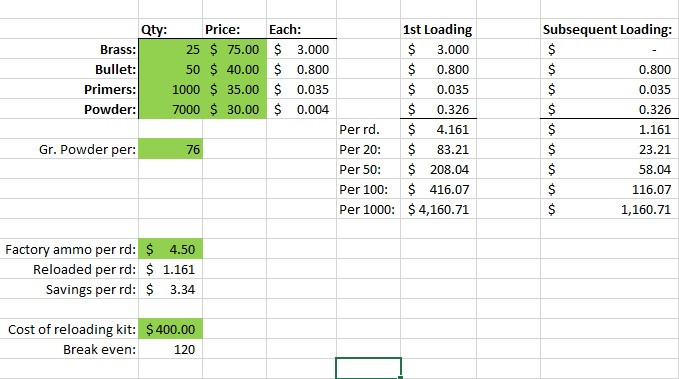 If you buy a good reloading kit, like RCBS RockChucker kit, thats about $400. You would have to reload 120 rounds of .338 Lapua for it to pay for itself. Or reload 329~ rounds of .300 Win Mag.
If you buy a good reloading kit, like RCBS RockChucker kit, thats about $400. You would have to reload 120 rounds of .338 Lapua for it to pay for itself. Or reload 329~ rounds of .300 Win Mag.
Seems like a good deal, right? It is…until you get into economies of scale. Federal cranks out a bazillion rounds of 5.56 every year for the military. As a result, they’ve got the whole thing dialed in…they’ve got their costs down, their equipment amortized, production streamlined…as a result they can make 5.56 so cheap that you almost don’t want to waste your time reloading. Let’s check out some 55 gr. FMJ Federal ammo:
- Federal 820 rounds for about $350 (From Midway)
- Hornady brass at $0.29 each
- 55 gr. FMJ at $.0.13
- 25 grains of powder
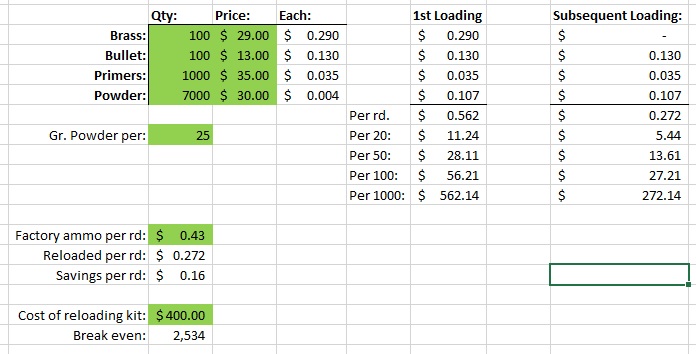 Admittedly, almost no one uses new commercial brass to load .223 since fired brass is available at virtually no cost. But, for consistency….
Admittedly, almost no one uses new commercial brass to load .223 since fired brass is available at virtually no cost. But, for consistency….
You’re at $0.56 per round for your first loading…thats actually more than what factory ammo costs. However, once you fire that off and reload it, you drop down by sixteen cents per round. Put another way, you paid Midway $350 but once you fire it off that ammo can be reloaded at around $227.
When you get into stuff like 9mm and .223 the savings really become negligible when you factor in your time and whatnot. However, when ammo isn’t available at any price, then the advantages become readily apparent.
If you want to play “what if”, I’ll give you a copy of the spreadsheet. Anything in green is a variable that you can tinker with. Crunch some numbers. You’ll see that if you’re a guy who shoots oddball calibers (Weatherby, Ultramag, Lapua, etc.) you can save some serious coin. Explore your options – what if you get a really good deal on powder? What if you use inexpensive cast bullets? What if you use cheap once-fired brass?
If you find this info useful….

